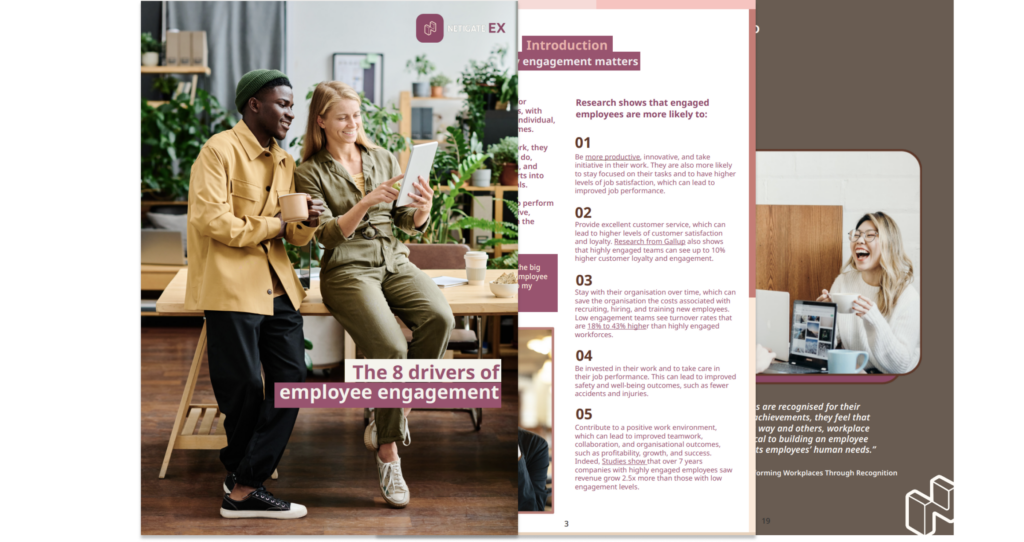Table of Contents
The 8 drivers of employee engagement

The long and short of it is that it’s good to be engaged at work (you can read more about the ‘why’ here). But what is it that really drives employee engagement? At Netigate, we’ve combined our own experience with in-depth research to uncover the 8 key drivers of employee engagement.
Download The 8 drivers of employee engagement for a more in-depth look at the drivers
Leadership
Business leaders have a profound impact on employee engagement. They set the tone for the work environment and shape the relationship between leaders at all levels and their teams. By cultivating a supportive and inspiring culture, practicing effective communication, providing clear expectations, and recognising and valuing employee contributions, leaders can foster higher levels of engagement and motivation among their employees.
The three leadership subdrivers are: communication with, feedback from, and trust in one’s immediately manager.
Growth and enablement
When employees have opportunities to learn new skills, expand their knowledge, and advance their careers, it ignites a sense of personal and professional growth. This not only enhances their confidence and competence but also demonstrates that the company values their potential and invests in their future.
When employees feel supported in their growth journey, they are more likely to be motivated, dedicated, and committed to their work. They become active contributors, bringing fresh ideas, innovation, and a sense of ownership to their roles.
The two growth and enablement subdrivers are: Autonomy and enablement and professional growth.
Relationships
The relationships we have at work play a vital role in shaping our levels of engagement. Beyond our daily tasks and deadlines, it’s the connections we have with our colleagues and leaders that create a sense of belonging and purpose within the workplace.
In fact, research on self-determination theory shows that levels motivation in the workplace are significantly impacted by our feelings of connection to others.
The three relationship subdrivers are: collaboration, trust, and communication between peers at work.

Culture
Workplace culture is the vibrant tapestry of values, beliefs, behaviours, and norms that shape the environment where employees thrive. It’s the personality of an organisation, influencing how people interact, collaborate, and find meaning in their work.
A strong and positive culture fosters a sense of belonging, trust, and purpose, empowering employees to contribute their best selves and creating an atmosphere where everyone feels valued and motivated.
The three culture subdrivers are: open communication, diversity and inclusion, and influence.
Alignment
Alignment in the workplace plays a pivotal role in boosting employee engagement, leading to a more motivated, committed, and productive workforce. When employees feel aligned with the company’s goals, values, and vision, they develop a sense of purpose and connection to their work.
The two alignment subdrivers are: goal alignment and values.
| Signs of a well-aligned team | Signs of alignment issues |
| High engagement scores and employee retention. | Low or falling engagement scores and increasing employee turnover. |
| Clearly defined tasks and good communication. | Miscommunications, uncertainty and confusion are common. |
| Tasks are completed on time and to brief. | Deadlines are often missed and work is not as expected. |
| Goals are achieved by teams and across the company. | Goals are often missed or not achieved. |
| Well-defined channels for task management and communication. | Excessive meetings and lack of clarity on where to find information. |
Meaningful work
Meaningful work refers to the sense of purpose, fulfilment, and significance that we experience in our professional endeavours. It goes beyond just completing tasks and earning a salary. It involves a deep connection between one’s values, passions, and the impact they make through their work.
Meaningful work can vary from person to person, as it is often tied to individual values, interests, and goals.
The two meaningful work subdrivers are: accomplishment and personal impact.

Recognition and reward
Research by Gallup and Workhuman shows that employees who feel “fulfilled by recognition” are 4x as likely to be engaged as their counterparts who do not.
In fact, employees who don’t feel recognised in the workplace are 8x more likely to be actively disengaged.
This goes to show how important it is to recognise your employees’ achievements and compensate them accordingly.
The three recognition and reward subdrivers are: compensation, benefits, and recognition.
Wellness
“Well-being isn’t just an absence of disease or disorders. It’s at the heart of how we think, work, manage emotions, and interact with others.”
– Headspace, Well-being in the world of work
Employee engagement flourishes when individuals feel supported, energised, and balanced.
By investing in employee wellness initiatives, companies not only demonstrate their commitment to their employees’ physical and mental well-being, but also create an environment where individuals can thrive and bring their best selves to work.
From fostering a positive work-life balance to promoting stress management and overall health, wellness initiatives fuel the energy, enthusiasm, and productivity that drive employee engagement.
The four wellness subdrivers are: workload, wellbeing, work environemtn, and psychological safety.
-
Natasha Ellis-Knight
-
Natasha Ellis-Knight
- 4 min read
- .






 Copyright © 2025 Netigate AB, Drottninggatan 25, 111 51, Stockholm, Sverige
Copyright © 2025 Netigate AB, Drottninggatan 25, 111 51, Stockholm, Sverige